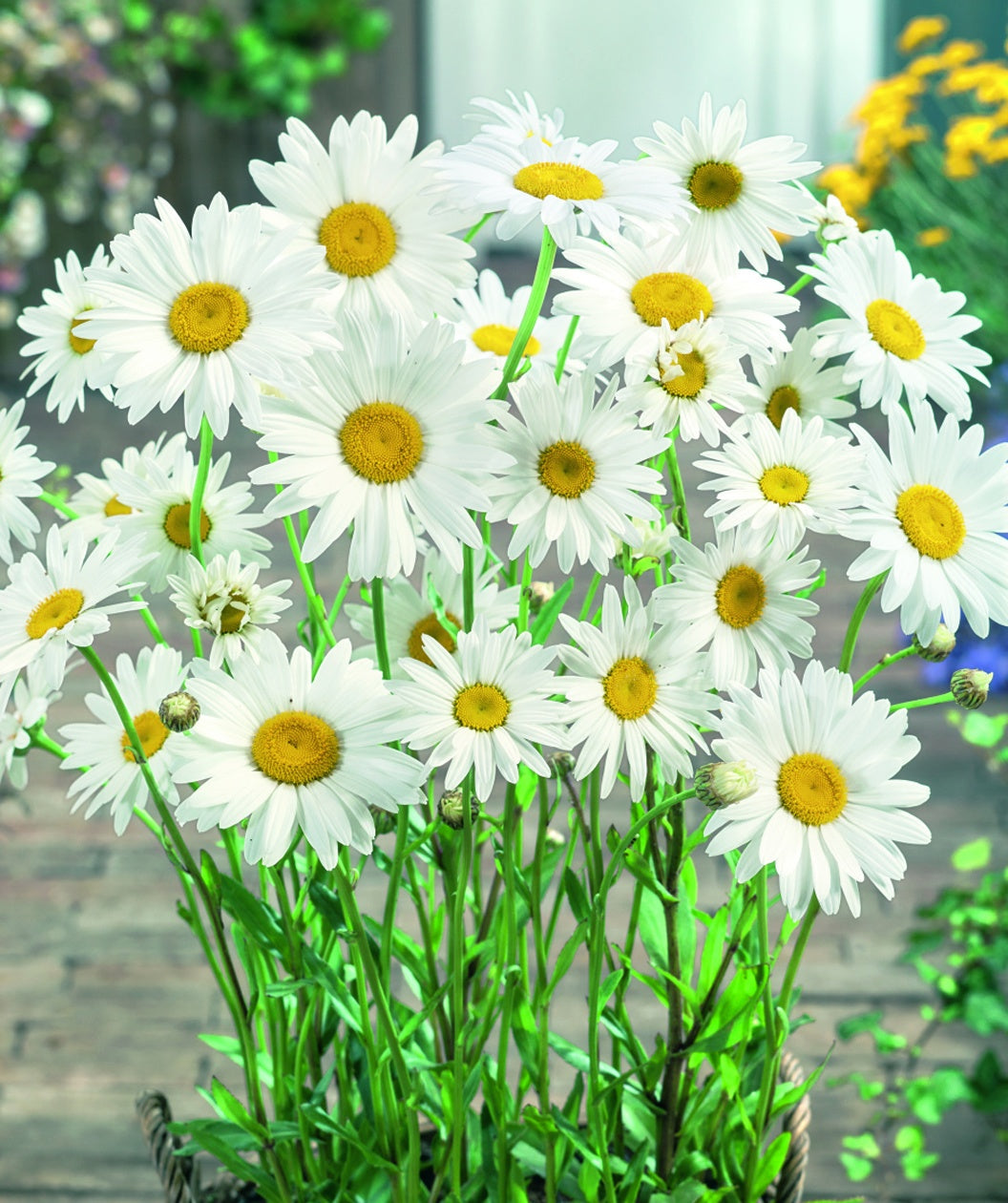BRIGHT WHITE, DELIGHTFUL DAISY BLOOMS FOR LONG-LASTING SUMMER COLOR
FEATURES:
- Beautiful, long lasting blooms appear from July through September
- Encourage a longer blooming period by deadheading the blooms
- Large flowers on sturdy stems make this an ideal cut flower for arrangements
- Long, sturdy stems stand strong through all kinds of weather, making staking not necessary
- Pollinator friendly, deer and rabbit resistant
- Plant in a perennial border, along your walkways, in a cottage garden or in a mass planting
- Hand Selected, Fresh from the Grower
- Ships in a plant-safe designed box
Growth Facts
- Hardiness Zone: 5-9
- Mature Height: 3-4' tall
- Mature Width: 2-3' wide
- Exposure: Full Sun
- Spacing: 2-3' apart
BRIGHT WHITE, DELIGHTFUL DAISY BLOOMS FOR LONG-LASTING SUMMER COLOR
FEATURES:
- Beautiful, long lasting blooms appear from July through September
- Encourage a longer blooming period by deadheading the blooms
- Large flowers on sturdy stems make this an ideal cut flower for arrangements
- Long, sturdy stems stand strong through all kinds of weather, making staking not necessary
- Pollinator friendly, deer and rabbit resistant
- Plant in a perennial border, along your walkways, in a cottage garden or in a mass planting
- Hand Selected, Fresh from the Grower
- Ships in a plant-safe designed box
Growth Facts
- Hardiness Zone: 5-9
- Mature Height: 3-4' tall
- Mature Width: 2-3' wide
- Exposure: Full Sun
- Spacing: 2-3' apart
Why plant Becky Shasta Daisy?
Fresh as a Daisy! Does any Spirit have a more delightful presence in the summer garden? Everybody loves these gleaming white and yellow blossoms. Becky is an especially choice selection of Shasta Daisy that stands strong and tall through all kinds of weather with no staking. Plant this perky performer in the middle or back of your border along with Daylilies, Russian Sage, Beebalm, and Blazing Star for a colorful, long-lasting summer display. No cottage garden planting should be without it, and Becky looks polished enough to suit formal landscapes, too.
The wild Daisy you see growing along the roadsides is the weedy European import called the Oxeye Daisy. In the 1890s, legendary plant breeder Luther Burbank set out to make it a better garden plant. He hybridized the Oxeye Daisy with two other European daisies and a Japanese Daisy for good measure. Burbank worked in California and named his introduction after Mt. Shasta in the northern part of that state. The Becky Shasta Daisy was named after landscape designer Becky Stewart of Decatur, Georgia. In 2003, the Perennial Plant Association named this stellar Spirit their “Perennial Plant of the Year,” a great honor.
How to use Becky Shasta Daisy in the landscape?
You can also enjoy Becky Shasta Daisy indoors, as a cut flower. Show your kids how to put food coloring in the water to change the flower color—like you did when you were a kid!
Planting Zones
Hardiness Zone: 5-9
How To Plant Becky Shasta Daisy
Becky Shasta Daisy likes to be in full sun, though it will tolerate very light shade. It appreciates regular water, but it needs freely draining soil, especially in winter, when it is vulnerable to rotting in saturated ground. Cut the flower stems down in fall if you find them unsightly; otherwise, wait until spring to do so. The foliage will remain evergreen in mild climates. Dig up and divide clumps every two or three years to keep plants growing vigorously.
How To Water
When established, the Becky Shasta Daisy is drought tolerant. However, the first year of planting, you'll need to keep the soil moist to ensure it is receiving a sufficient amount of water. Remember, not too much though - the roots can rot if overwatered and in a location without well draining soil.
How To Fertilize
When planting, you should fertilize your new Becky Shasta Daisy with the Bower & Branch Starter Plant Food to ensure it is receiving the nutrients it needs to thrive. Repeat this once a year, in spring, to encourage healthy foliage and blooms year after year!
How To Prune
Each fall, just before winter sets in clean up the previous years foliage and compost it. Be sure your perennials are mulched well for winter protection. Two inches of an organic mulch will do the job. Consider leaving the plant debris in place through the winter and doing your clean up on the weather warms in the spring. While it doesn't make things neat and tidy, the debris provides overwintering protection for insects, their eggs and pupae including our native Viceroy butterfly.





